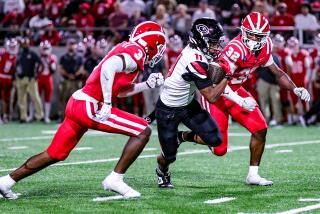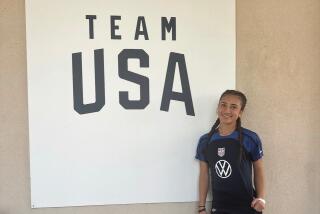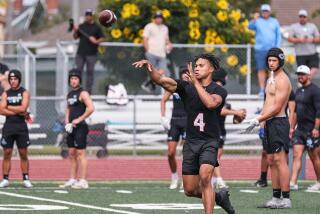Safety Spawns Good Cheer : Competition Along Sidelines Growing; Camps Help Prepare Tougher Routines
From 7 to 9 a.m., five days a week, week in and week out since school let out in mid-June, cheer captain Sharon Hey has led her 17-member Mira Mesa High School squad through yells, dances, partner stunts and human pyramids, all to perfect their many routines for the upcoming school year.
Members of an equally well-honed pep group from Monte Vista High in Spring Valley scream out cheers and jump on one another’s shoulders from 8 to 10 a.m. daily, polishing up what they, Mira Mesa and most other area high school squads learned at various weeklong professional cheerleader camps earlier this summer.
Throughout the county, hundreds of girls--and a growing number of boys--are preparing the final touches before nine months of spirit-boosting appearances begin at school assemblies and civic events, at high school sports from football to cross-country to wrestling, and increasingly at regional, state and national gymnastics-type competitions among school squads.
With the cost of a cheerleading year averaging $500--which covers camp training and dress ensembles, including pompons, megaphones and athletic shoes--and months of athletic training behind them, high school cheerleaders today commit themselves to a grueling and expensive, though rewarding, activity.
“Cheerleading today is a lot more than a bunch of silly little girls jumping around,” said John Ferguson, the Monte Vista photography teacher who has supervised the cheer squad for the past nine years. “It’s now much more a sport.”
The cheerleaders at Bonita Vista High School are more athletic now than in years past as high school routines have become more complex, said adviser Ralph Carrier at the Sweetwater District school in eastern Chula Vista.
Gymnastics Training
“Of the (16-member) squad today, as many as seven have some gymnastics training and many can do back handsprings, etc.,” added Mira Mesa adviser Mary Jensen. “Five years ago, I maybe had one who could perform such springs, and I had no gymnasts.”
The trend toward competitive cheerleading at the high school level follows that established among top college cheer teams over the past decade with their pyramids and other athletic maneuvers. Such stunts excite crowds more than the simple cheers and dance routines of the past.
Along with more athletic routines has come increased emphasis on safety and on proper coaching. A couple of serious injuries among college cheerleaders in the past two years has led various national cheerleading organizations to recommend limits on the height and complexity of stunts.
“Young people at the high school age have no fear and tend to feel immortal,” said Laura Charles, who coached National City’s Sweetwater High School team until June. “But you can’t defy the law of gravity, and an adviser always has to be ready to say ‘no’ to something that could be unsafe, which could be any time both feet leave the ground.”
Competitive cheerleading among San Diego County high schools actually has lagged behind that in most other areas of the country, including Los Angeles and Orange counties, according to Jim W. Hawkins, a Sweetwater district teacher and pep booster known as “Mr. Cheerleader of San Diego.” Hawkins sponsors local clinics and names all-star cheerleaders from schools countywide at the end of the academic year.
“The competitive aspects take quite a lot of training, as well as needing to know safety aspects and in getting sponsors,” Hawkins said in an interview. A school such as Los Alamitos High School in Orange County hires special coaches and choreographers to ensure award-winning routines at competitions held at places such as Magic Mountain each fall, he said.
El Cajon Valley High School now hires a former San Diego State University cheerleader to help the squad perfect routines.
“We decided to do it specifically because of the dangers involved now,” Emily Barton, the El Cajon adviser, said. “We want the kids to be sure they know what they are doing, since pyramids and partner stunts are the coming thing.”
The proliferation of cheerleading camps across the country are in part because of a move toward more demanding formations. Such organizations as the United Spirit Assn. (USA), the National Cheerleaders Assn. (NCA) and the Dynamic Cheerleaders Assn. (DCA) all run summer camps.
For most high school squads, the camps--at $155 and up, not including transportation--are required.
“Schools look for quality in camps, where the skills of tumbling and mounts are taught carefully,” Hawkins said.
Prevention of Injuries
Monte Vista’s Ferguson accompanies his squad to one of the USA camps held each summer on the UC Irvine campus. “They learn techniques at camp as well as how to spot and how to do crowd control,” Ferguson said. “And while they are learning those things, I am there with (other advisers) talking about organization of cheer squads, prevention of injuries and the like.”
Said Mira Mesa adviser Jensen: “I need to go to to camp to learn safety aspects to be able to emphasize it to the kids. So my role is to tell them ‘no’ at times, such as new rules that pyramids cannot be more than two persons high, since (publicity) from the college injuries has led to concerns about liability.
“They know the routines themselves better than I would ever know and can teach them to one another. I always make the kids have an active spotter, and have everyone watching with their hands up, and not to get silly, since that is when people get hurt.”
Schools now require that cheerleaders pass physical examinations similar to those given participants in varsity sports and that they carry insurance.
“You learn to keep in shape because if you’re not, you can’t do the routines,” Monte Vista senior Irene Navarro said. “We do some (weightlifting) because the better your build, the less things hurt since we do take a lot of falling,” another pep squad veteran, Myra Desquitado, said. Many of the Monte Vista girls join varsity sports during the spring.
And the cheerleaders do come away from camp with an added appreciation for safety.
“Very, very, very much so,” Sharon Hey of the Mira Mesa squad said. “We’re always thinking about it.” There have been no major injuries from cheerleading in the county, but broken ankles and other assorted bruises occur from time to time.
Growing Number of Boys
“Camp teaches you to fall properly,” junior Kevin Mejia, one of two boys on the Mira Mesa squad, said. “It’s a year-sport that has to be practiced every day.” The athletic Mejia, along with several other Mira Mesa cheerleaders, practices gymnastics regularly at a neighborhood health club.
And Mejia is one of a growing number of boys who participate in cheer.
“People tease guys when they first try out,” said Mira Mesa co-captain Buffy Whiteman. “But we had one guy who cheered for us last year who is going to be an instructor at one of the camps, and hopefully (the example of him) and Kevin will encourage more guys to try out.”
Mejia said he joined the squad two years ago “after I saw a (regional) competition at Magic Mountain and thought it was really a lot of fun.
“I do the dance routines, everything that the girls do except run around in pompons. I tell guys who tease me that if you don’t like it, you go out and try all the lifts and then tell me that it’s easy or that it’s not a sport.”
Mejia, who would like to become a summer camp instructor during his college years, has helped choreograph the squad’s special routine that it will use at upcoming regional competitions among state high schools.
Good Students
“Sports (at Mira Mesa) are our first obligation, but if we can branch out and do competition as well, that is very nice because competitions turn on the school and the kids even more to the positive aspects of cheer,” adviser Jensen said. Mira Mesa finished 12th out of 93 schools at Magic Mountain last year, and is gunning for the top 10 this fall to qualify for national cheer-offs in Florida next spring.
All the activity forces cheerleaders to budget their time for academics carefully.
“I find that many on the squad have 4.0 (grade-point) averages,” Ferguson of Monte Vista said. “They are good students.”
The perception of squad members as positive role models for high schools is shared countywide.
“They are always enthusiastic and provide real leadership for the school,” Carrier of Bonita Vista said.
“For me, this is a joy to do because the kids are the nicest kids on campus--warm, caring, hard workers, honest and not stuck up,” said Jensen. She and her husband, an El Cajon firefighter, spend a lot of their own time ferrying the cheerleaders from event to event.
For the students, the sacrifices of time also prove rewarding.
“I had to choose between a car and cheer,” said Diana Miranda of Monte Vista, noting that the money she has earned toward the $500 cost of being a cheerleader could have been applied toward a down payment on a car.
“But I have the rest of my life to get a car, and I only go to high school once, for four years.”
More to Read
Get our high school sports newsletter
Prep Rally is devoted to the SoCal high school sports experience, bringing you scores, stories and a behind-the-scenes look at what makes prep sports so popular.
You may occasionally receive promotional content from the Los Angeles Times.






